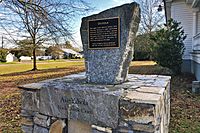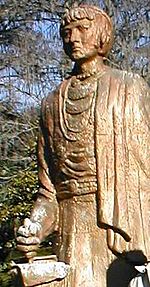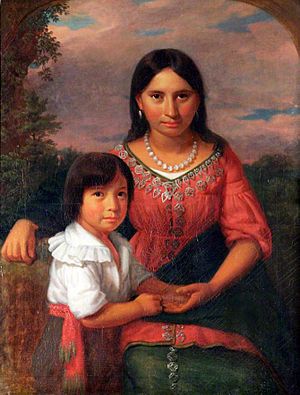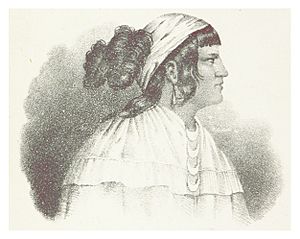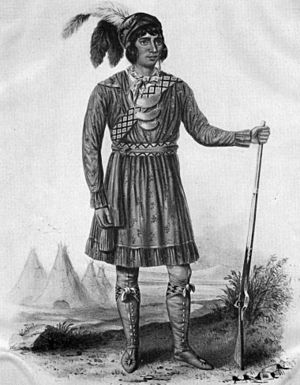Osceola facts for kids
Quick facts for kids
Osceola
|
|
|---|---|
|
Asi-yahola
|
|
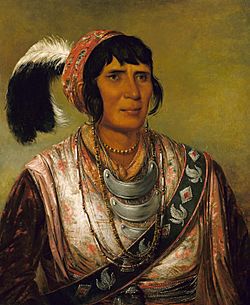
Osceola by George Catlin, 1838
|
|
| Seminole leader | |
| Personal details | |
| Born | 1804 Talisi, Mississippi Territory, US |
| Died | January 30, 1838 (aged 33–34) Fort Moultrie, South Carolina, US |
| Resting place | Fort Moultrie, South Carolina, US |
| Children | at least five |
| Parents | Polly Coppinger and William Powell |
| Nickname | Billy Powell |
Osceola (born Billy Powell in 1804) was a very important leader of the Seminole people in Florida. His name in the Creek language was Asi-yahola. He was born in Alabama, and his mother was Muscogee. His great-grandfather was from Scotland.
When Osceola was a child, his family moved to Florida. They joined other Red Stick refugees after a big war in 1814. These groups later became known as the Seminole people.
In 1836, Osceola led a small group of warriors. They fought against the United States during the Second Seminole War. The U.S. government wanted to move the Seminole tribe from their lands in Florida to a new area west of the Mississippi River. Osceola became an important adviser to Micanopy, the main chief of the Seminole.
Osceola led the Seminole resistance until he was captured. This happened on October 21, 1837. He was tricked into coming to peace talks near Fort Peyton under a flag of truce. The U.S. first held him at Fort Marion in St. Augustine. Then, they moved him to Fort Moultrie in Charleston, South Carolina. He died there a few months later from an infection or malaria. Many people visited Osceola in prison, including the famous artist George Catlin. Catlin painted a well-known picture of the Seminole leader.
Contents
Osceola's Early Life
Osceola was born Billy Powell in 1804. His birthplace was a Creek village called Talisi, which means "Old Town." Today, this area is the city of Tallassee, Alabama. It was located near the Tallapoosa River. The people living in Talisi were a mix of different groups, including the Muscogee Creek. Some Muscogee also had enslaved Black people.
Billy Powell's mother was Polly Coppinger. She was a mixed-race Creek woman. His father was likely William Powell, a Scottish trader. Polly also had Muscogee and European ancestors. The Muscogee people followed a matrilineal system. This means children belonged to their mother's family or "clan." They were raised by their mothers and their mother's male relatives. This is how they gained their social status.
Billy Powell's maternal grandfather, James McQueen, was a Scottish sailor. In 1716, he became the first white person known to trade with the Muscogee Creek people in Alabama. He stayed there as a fur trader and married into a Muscogee family.
In 1814, after the Red Stick Muscogee Creeks lost a war against the United States, Polly moved with Osceola and other Muscogee people to Florida. There, they joined the Seminole. As an adult, Billy Powell was given the name Osceola. This name comes from the Creek words Asi-yahola. Asi refers to a special ceremonial black drink made from the yaupon holly. Yahola means "shout" or "shouter."
In 1821, the United States took control of Florida from Spain. More European-American settlers began moving into the area. This meant they were taking over Seminole lands. After some early fights and a treaty in 1823, Osceola and his family moved deeper into central and southern Florida.
Osceola had two wives, which was common for some high-ranking Muscogee and Seminole leaders. He had at least five children. One of his wives was Black. Osceola strongly believed that free people should not be enslaved.
Fighting for Freedom
During the 1820s, American settlers kept asking the U.S. government to move the Seminole out of Florida. They wanted the land for farming. In 1832, some Seminole chiefs signed the Treaty of Payne's Landing. This treaty said they would give up their Florida lands for new lands west of the Mississippi River.
There's a famous story that Osceola stabbed the treaty with his knife. While there are no reports from that time confirming this, a historian later found a small, knife-shaped hole in the original treaty document.
Five important Seminole chiefs, including Micanopy, did not agree to move. Because of this, the U.S. Indian agent, Wiley Thompson, said these chiefs were no longer leaders. As relations between the U.S. and the Seminole got worse, Thompson stopped selling guns and ammunition to the Seminole. Osceola, who was becoming a respected warrior, was very upset by this. He felt it was like treating the Seminole like slaves, who were not allowed to carry weapons.
Thompson thought Osceola was a friend and even gave him a rifle. Osceola often went to Thompson's office to complain loudly. One time, Osceola argued with Thompson, who had him locked up at Fort King for two nights. Osceola agreed to be more respectful and sign the treaty to get released. But after this humiliating experience, Osceola secretly planned his revenge against Thompson.
On December 28, 1835, Osceola used the rifle Thompson had given him to kill the Indian agent. Osceola and his followers also shot six other people outside Fort King. At the same time, another group of Seminole attacked and killed over 100 U.S. Army troops. This group was marching from Fort Brooke to Fort King. Americans called this event the Dade Massacre. These attacks started the Second Seminole War with the United States.
Capture and Final Days
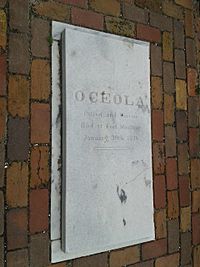
On October 21, 1837, Osceola and 81 of his followers were captured. This happened near St. Augustine at Fort Peyton. General Joseph Marion Hernández captured them under the orders of General Thomas Jesup. Osceola had gone there for peace talks, trusting a white flag of truce.
Osceola was first held at Fort Marion in St. Augustine. Later, he was moved to Fort Moultrie on Sullivans Island, near Charleston, South Carolina. Many people were angry about Osceola's capture because he was tricked. General Jesup's actions were criticized by many leaders and the international press. His betrayal of the truce flag is seen as a very shameful act in American military history.
In December, Osceola and other Seminole prisoners were moved to Fort Moultrie. Many people from the town visited them. Artists like George Catlin, W. M. Laning, and Robert John Curtis painted Osceola's portrait. They did this even though he was very sick. Osceola and Curtis became friends, talking a lot during the painting sessions. Curtis painted two oil portraits of Osceola. These paintings later inspired many popular prints and even cigar store figures.
Osceola had suffered from malaria since 1836. He also had a severe throat infection called tonsillitis, which led to an abscess. He died from this on January 30, 1838, just three months after his capture. He was buried with military honors at Fort Moultrie.
Osceola's Legacy
Many places are named after Osceola to honor him:
- Several counties in the U.S., including Florida, Iowa, and Michigan.
- The town of Osceola, New York.
- Osceola, Indiana, a town.
- Osceola, Iowa, a county seat.
- Osceola, Wisconsin, a village.
- Osceola Township, Renville County, Minnesota.
- Florida's Osceola National Forest.
- Mount Osceola in the White Mountains of New Hampshire.
- Two lakes in Florida: one at the University of Miami and another in Winter Park.
- Battery Osceola at Fort Taylor in Key West, Florida.
- Osceola Hall, a dormitory at Florida State University.
- The town of Ocilla in southern Georgia might also be named after him.
- The World War II Liberty Ship SS Chief Osceola was named in his honor.
- Osceola is a symbol for the Florida State Seminoles football team.
Descendants
- Chairman Joe Dan Osceola (1936–2019), who was an ambassador for the Seminole Tribe, was Osceola's great-great-great grandson.
Osceola's Relics
After Osceola died, a U.S. Army officer named Pitcairn Morrison decided to make a death mask of him. This was a custom for important people at the time, but it was done without the permission of Osceola's people. A doctor made a plaster cast of Osceola's face and upper body.
Captain Pitcairn Morrison sent the death mask and some of Osceola's belongings to an army officer in Washington. By 1885, these items were kept in the anthropology collection of the Smithsonian Institution. Today, the death mask is at the New-York Historical Society.
Osceola in Popular Culture
Osceola's story has been told in many ways:
Books
- Osceola (1858) by Thomas Mayne Reid
- In the Wilds of Florida: A Tale of Warfare and Hunting (1880) by William Henry G. Kingston
- "Osceola" (1889), a poem by Walt Whitman, found in Leaves of Grass.
- "Osceola" was an early pen name used by Danish author Karen Blixen.
- War Chief of the Seminoles (1954), a children's book by May McNeer.
- Osceola, Häuptling der Seminole-Indianer (1963) by Ernie Hearting, a German novel.
- The Probability Broach (1979), a novel where Osceola is the ninth President of the North American Confederacy.
- A People's History of the United States (1980) by Howard Zinn.
- Tourist Season (1986) and Nature Girl (2006), mystery novels by Carl Hiaasen.
- Light a Distant Fire (1988) by Lucia St. Clair Robson.
- Captive (1996), a historical novel by Heather Graham.
- Freedom Land: A Novel (2003) by Martin L. Marcus.
- Osceola/ His Capture and Seminole Legends (2010), non-fiction by William Ryan.
- Osceola "Ossie" Bigtree is a character in Karen Russell's novel Swamplandia! (2011).
Movies
- In the mid-1930s, Nathanael West wrote a film idea called Osceola.
- Seminole (1953), a fictionalized American western film starring Anthony Quinn as Osceola.
- ...in the Sun (1957), a movie about Osceola's life and the Second Seminole War, starring James Craig.
- Osceola – Die rechte Hand der Vergeltung (1971), an East German western with Gojko Mitić as the Native American leader.
Television, Music, Sports, and Art
- The Sedgeford Hall Portrait (around 1830) is now thought to show Pe-o-ka (one of Osceola's wives) and their son.
- A 1957 Jim Bowie TV-series episode called "Osceola" featured him.
- The song "Seminole Wind" by John Anderson mentions hearing the ghost of Osceola.
- Osceola and Renegade are mascots for the Florida State Seminoles football team. The Seminole Tribe of Florida approved their use as a symbol.
See also
 In Spanish: Osceola para niños
In Spanish: Osceola para niños


